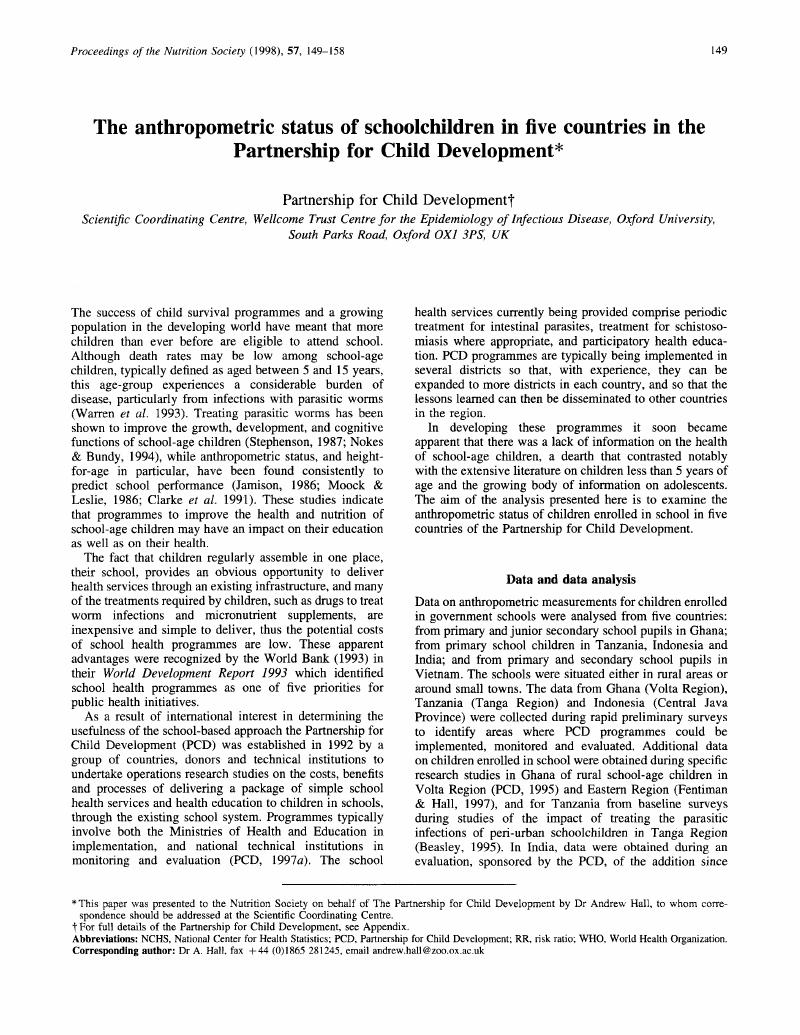Crossref Citations
This article has been cited by the following publications. This list is generated based on data provided by Crossref.
Beasley, N. M. R.
Tomkins, A. M.
Hall, A.
Kihamia, C. M.
Lorri, W.
Nduma, B.
Issae, W.
Nokes, C.
and
Bundy, D. A. P.
1999.
The impact of population level deworming on the haemoglobin levels of schoolchildren in Tanga, Tanzania.
Tropical Medicine & International Health,
Vol. 4,
Issue. 11,
p.
744.
Fernando, S. D.
Paranavitane, S. R.
Rajakaruna, J.
Weerasinghe, S.
De Silva, D.
and
Wickremasinghe, A. R.
2000.
The health and nutritional status of school children in two rural communities in Sri Lanka.
Tropical Medicine & International Health,
Vol. 5,
Issue. 6,
p.
450.
Jinabhai, C. C.
Taylor, M.
Coutsoudis, A.
Coovadia, H. M.
Tomkins, A. M.
and
Sullivan, K. R.
2001.
A health and nutritional profile of rural school children in KwaZulu-Natal, South Africa.
Annals of Tropical Paediatrics,
Vol. 21,
Issue. 1,
p.
50.
Fentiman, Alicia
Hall, Andrew
and
Bundy, Don
2001.
Health and cultural factors associated with enrolment in basic education: a study in rural Ghana.
Social Science & Medicine,
Vol. 52,
Issue. 3,
p.
429.
Beasley, Michael
Brooker, Simon
Ndinaromtan, Montanan
Madjiouroum, Ester M.
Baboguel, Marie
Djenguinabe, Elie
and
Bundy, Don A. P.
2002.
First nationwide survey of the health of schoolchildren in Chad.
Tropical Medicine & International Health,
Vol. 7,
Issue. 7,
p.
625.
Ulukanligil, Mustafa
and
Seyrek, Adnan
2003.
Demographic and parasitic infection status of schoolchildren and sanitary conditions of schools in Sanliurfa, Turkey.
BMC Public Health,
Vol. 3,
Issue. 1,
Ulukanligil, M
and
Seyrek, A
2004.
Anthropometric status, anaemia and intestinal helminthic infections in shantytown and apartment schoolchildren in the Sanliurfa province of Turkey.
European Journal of Clinical Nutrition,
Vol. 58,
Issue. 7,
p.
1056.
Ulukanligil, M
and
Seyrek, A
2004.
Demographic and socio-economic factors affecting the physical development, haemoglobin and parasitic infection status of schoolchildren in Sanliurfa province, Turkey.
Public Health,
Vol. 118,
Issue. 2,
p.
151.
Friedman, J F
Phillips-Howard, P A
Mirel, L B
Terlouw, D J
Okello, N
Vulule, J M
Hawley, W A
Nahlen, B L
and
ter Kuile, F
2005.
Progression of stunting and its predictors among school-aged children in western Kenya.
European Journal of Clinical Nutrition,
Vol. 59,
Issue. 8,
p.
914.
Hall, Andrew
2005.
Beyond deworming.
The Lancet,
Vol. 365,
Issue. 9461,
p.
751.
Leenstra, T
Petersen, L T
Kariuki, S K
Oloo, A J
Kager, P A
and
Kuile, F O ter
2005.
Prevalence and severity of malnutrition and age at menarche; cross-sectional studies in adolescent schoolgirls in western Kenya.
European Journal of Clinical Nutrition,
Vol. 59,
Issue. 1,
p.
41.
Ekpo, Uwem Friday
Odoemene, Simon Nnayere
Mafiana, Chiedu Felix
Sam-Wobo, Sammy Olufemi
and
de Silva, Nilanthi
2008.
Helminthiasis and Hygiene Conditions of Schools in Ikenne, Ogun State, Nigeria.
PLoS Neglected Tropical Diseases,
Vol. 2,
Issue. 1,
p.
e146.
Hall, Andrew
Kassa, Tamiru
Demissie, Tsegaye
Degefie, Tedbabe
and
Lee, Seung
2008.
National survey of the health and nutrition of schoolchildren in Ethiopia.
Tropical Medicine & International Health,
Vol. 13,
Issue. 12,
p.
1518.
Rah, Jee H
Christian, Parul
Shamim, Abu Ahmed
Arju, Ummeh T
Labrique, Alain B
and
Rashid, Mahbubur
2009.
Predictors of stunting and thinness in post-menarcheal adolescent girls in rural Bangladesh.
Public Health Nutrition,
Vol. 12,
Issue. 12,
p.
2400.
Osei, Akoto
Houser, Robert
Bulusu, Saraswati
Joshi, Tripti
and
Hamer, Davidson
2010.
Nutritional Status of Primary Schoolchildren in Garhwali Himalayan Villages of India.
Food and Nutrition Bulletin,
Vol. 31,
Issue. 2,
p.
221.
Rousham, Emily K
Roschnik, Natalie
Baylon, Melba Andrea B
Bobrow, Emily A
Burkhanova, Mavzuna
Campion, M Gerda
Adle-Chua, Teresita
Degefie, Tedbabe
Hilari, Caroline
Kalengamaliro, Humphreys
Kassa, Tamiru
Maiga, Fadima
Mahumane, Bonifacio J
Mukaka, Mary
Ouattara, Fatimata
Parawan, Amado R
Sacko, Moussa
Patterson, David W
Sobgo, Gaston
Khandaker, Ikhtiar Uddin
and
Hall, Andrew
2011.
A comparison of the National Center for Health Statistics and new World Health Organization growth references for school-age children and adolescents with the use of data from 11 low-income countries.
The American Journal of Clinical Nutrition,
Vol. 94,
Issue. 2,
p.
571.
Daboné, Charles
Delisle, Hélène F
and
Receveur, Olivier
2011.
Poor nutritional status of schoolchildren in urban and peri-urban areas of Ouagadougou (Burkina Faso).
Nutrition Journal,
Vol. 10,
Issue. 1,
Lwanga, Francis
Kirunda, Barbara Eva
and
Orach, Christopher Garimoi
2012.
Intestinal Helminth Infections and Nutritional Status of Children Attending Primary Schools in Wakiso District, Central Uganda.
International Journal of Environmental Research and Public Health,
Vol. 9,
Issue. 8,
p.
2910.
Srivastava, Anurag
Mahmood, Syed E
Srivastava, Payal M
Shrotriya, Ved P
and
Kumar, Bhushan
2012.
Nutritional status of school-age children - A scenario of urban slums in India.
Archives of Public Health,
Vol. 70,
Issue. 1,
Panigrahi, Ansuman
and
Das, Sai Chandan
2014.
Undernutrition and Its Correlates among Children of 3–9 Years of Age Residing in Slum Areas of Bhubaneswar, India.
The Scientific World Journal,
Vol. 2014,
Issue. ,
p.
1.



